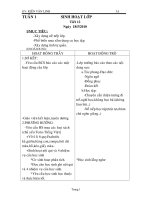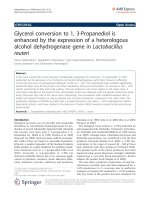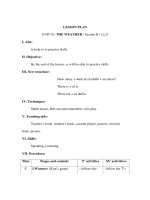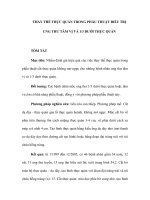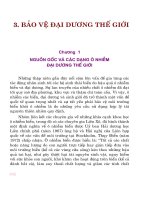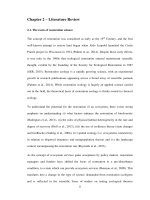Slides 1 3 demonstrate how transactions affect the accountin
Bạn đang xem bản rút gọn của tài liệu. Xem và tải ngay bản đầy đủ của tài liệu tại đây (1.43 MB, 73 trang )
Demonstrate How Transactions
Affect the Accounting Equation
© Dale R. Geiger 2011
1
Questions to Consider
• Does “the Government” overspend its budget?
• Who decides how much to spend?
• How do managers make sure they don’t overspend?
© Dale R. Geiger 2011
2
Terminal Learning Objective
• Task: Demonstrate How Transactions Affect the Accounting
Equation Under the Budgetary and Accrual Methods of Accounting
• Condition: You are training to become an ACE with access to ICAM
course handouts, readings, and spreadsheet tools and awareness of
Operational Environment (OE)/Contemporary Operational
Environment (COE) variables and actors
• Standard: with at least 80% accuracy
•
•
•
•
Calculate Unobligated Balance
Determine the difference between budgetary and accrual methods
Analyze Transactions using the tabular format
Enter relevant scenario data into Excel spreadsheet to prepare basic
budgetary and accrual accounting reports
© Dale R. Geiger 2011
3
Financial Planning and Control
• You have been hired as a budget consultant by the
Simmons family
• Gomer, Madge, Bert, Lacy and Maddie
• Gomer’s monthly paycheck is Estimated to be
$1000.
• How should they spend it?
© Dale R. Geiger 2011
4
The Envelope System
• Predetermines Amounts to be Spent for Various Needs
• Sets Money Aside for Specified Purpose
• Prohibits Spending for Other than Intended Purpose--Can’t
Take Money from One Envelope and Put in Another
© Dale R. Geiger 2011
5
Spending Authority
© Dale R. Geiger 2011
6
Controlling the Budget
• Appropriations, Obligations Expenditures
• Appropriations ensure that funds are spent as the
Voting Body intends
• The Obligation process ensures that
Appropriations are not overspent
• Estimated Revenues Revenues
• Estimated Revenues give a basis of comparison for
Actual Revenues
© Dale R. Geiger 2011
7
Spending Process
© Dale R. Geiger 2011
8
Budgetary Accounting
• Provides a Control Mechanism to Prevent Overspending Funds
• Does proper budgetary accounting prevent deficits? Why or
why not?
• It DOES prevent overspending
• It does NOT prevent revenue shortfalls
• It does NOT prevent over-appropriating by the
legislative body
© Dale R. Geiger 2011
9
Check on Learning
• What mechanisms exist to control expenditures?
• What is the step in the spending authorization process that
releases funding quarter by quarter?
© Dale R. Geiger 2011
10
Gomer Makes a Purchase
• Gomer’s appropriation is $100
• Signs up for 3-month trial membership to the Doughnut of
the Month Club, $60
• Remove $60 from Gomer’s envelope
• Place in the “Obligated” envelope
• Key Point: Ordering triggers an Obligation
© Dale R. Geiger 2011
11
Gomer Makes a Purchase
• Receives first month’s shipment of Doughnuts with invoice
for $25:
• Remove $20 from the “Obligated” envelope
and replace in Gomer’s envelope
• Remove $25 from Gomer’s envelope and place
in “Expenditures” envelope
• Key Point: Receiving goods and services
triggers an Expenditure
© Dale R. Geiger 2011
12
Tracking Gomer’s Unobligated Balance
• How much does Gomer have left to spend?
• Assume his original appropriation was $100
Unobligated
Open
= Appropriations - Expenditures
Balance
Obligations
© Dale R. Geiger 2011
13
Tracking Gomer’s Unobligated Balance
© Dale R. Geiger 2011
14
Key Points
• Ordering Goods or Services Triggers an Obligation
Prevents Overexpending Funds
• Receiving Goods or Services Triggers an Expenditure
Reverse Obligation
Record Expenditure
• Salaries, Wages and Other Recurring Expenditures are not
Obligated, but may be Committed
© Dale R. Geiger 2011
15
Check on Learning
• What is the equation to calculate Unobligated Balance?
• What is the event that triggers and Expenditure?
© Dale R. Geiger 2011
16
What’s the Difference?
• Consider the purchasing sequence:
Plan
Order
Receive
Pay
Consume
When does the Accounting System “count” the cost?
© Dale R. Geiger 2011
17
Why a Different Method of
Accounting?
• Different entities have different external reporting
requirements
• Individuals report income on a cash basis
• Governmental entities report activities on a
budgetary basis
• Businesses, revolving funds and the proprietary
governmental accounts report activities on an
accrual basis
© Dale R. Geiger 2011
18
What’s the Difference?
Plan
Order
Receive
© Dale R. Geiger 2011
Pay
Consume
19
What’s the Difference?
Plan
Commitment
Order
Obligation
Receive
Pay
Consume
Expenditure
© Dale R. Geiger 2011
20
What’s the Difference?
Plan
Order
Receive
Pay
Asset & Liability Remove Liability
© Dale R. Geiger 2011
Consume
Expense
21
Check on Learning
• Which method of accounting records the cost when cash is
paid?
• Which method of accounting records the cost when goods are
received?
© Dale R. Geiger 2011
22
Lacy’s Lemonade Stand
• Lacy Simmons receives a $200 transfer from the family to
start a lemonade stand.
• The lemonade stand will run as a Revolving Fund
• User Fees must cover costs
• Uses Accrual Basis of Accounting
• How does this differ from an appropriation?
© Dale R. Geiger 2011
23
The Accrual Basis of Accounting
• Focuses on exchange of Economic Resources
• Records Revenues in the period in which they are EARNED
• Providing a service
• Selling a product
Plan
Take
Orders
Complete Service
or Ship Product
Collect
Cash
Revenue & Non-Cash Asset
© Dale R. Geiger 2011
24
Revenue Comparison
• Cash Basis:
Plan
Take
Orders
Complete Service
or Ship Product
Collect
Cash
Take
Orders
Complete Service
or Ship Product
Collect
Cash
• Accrual Basis:
Plan
Revenue & Non-Cash Asset
© Dale R. Geiger 2011
25
